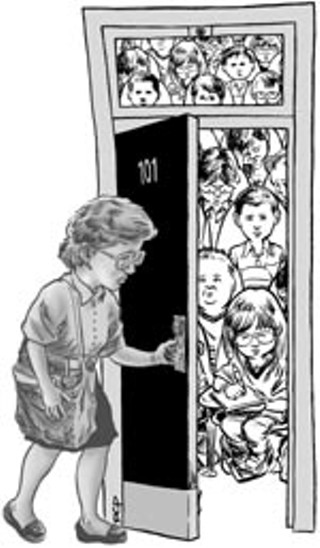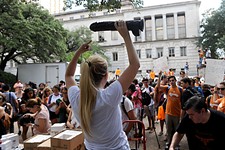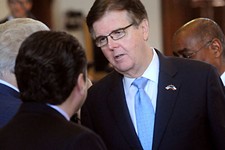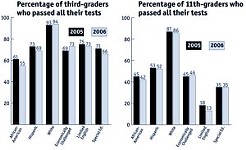Making Ends Meet
Proposed AISD budget looks to fill gaps, hold fort, and wait for the state
By Rachel Proctor May, Fri., Aug. 6, 2004

Few phrases make public school administrators tremble like "budget negotiations." And for good reason. For the last few years, Austin Independent School District budget debates have been scenes of high drama and angst, where teachers, trustees, and administrators have clashed over salaries, program cuts, and simply how to run the process.
Things are different this year. Trustee Cheryl Bradley characterized the process as the first in recent memory that hasn't been completely controversial, while trustee John Fitzpatrick called it the flat-out best he's ever seen. Larry Throm, AISD's chief financial officer, had a measure of his own.
"We held public hearings and 12 people showed up," he said.
This year's process, moving toward a final board vote on Aug. 23, lacks controversy for several reasons. Last year, statewide cuts, combined with a particularly hard hit from the recapture system, decimated AISD's finances, forcing administrators and the board to slash $20 million and 428 positions in a budget that three trustees voted against. Those cuts were enough to keep AISD in the black, if only barely, without hacking further away at existing programs this year.
That's not to say that this year the district is exactly flush. AISD's threadbare budget is still stretched tight by the redistributive school finance system known as "Robin Hood." Under this system, AISD is classified as "property-wealthy" and will return $136 million of its $732 million in available revenue to the state. That's 18% of the funds for a district where the property may be wealthy but the students are not – by one conventional measure, 52% of AISD students receive free or reduced-price lunch.
However, in a sad sign of the times, this $136 million payment actually counts as good news – due to flat property values in central Texas, it's $22 million less than the district sent away last year. The 2005 budget is also slightly plumper because of a greater administrative willingness to dip into the district's fund balance, or savings account.
Thus the administration's proposed 2005 budget has a little something for just about everyone: healthy raises for teachers, slight increases in staffing for support positions, and responses to areas of ongoing concern, such as safety. But while the harmonious process does indicate an overall sense of cooperation and goodwill – as well as a preoccupation with the weightier task of convincing voters to approve a looming $520 million bond package to fund capital improvements – it also indicates something a little less rosy: The budget is simply so tight that there's virtually nothing left to fight over. Nevertheless, board members remain optimistic that even if they're pinching pennies now, they are still laying the foundation to find better ways to educate Austin's increasingly diverse student body.
Dipping Into Savings
As any teacher will remind you, that begins with the folks with the chalk dust in their hair. About 85% of AISD's budget goes to salary. When those salaries don't keep up with Austin's cost of living, the administration and board are sure to hear about it. That's what happened last year – teachers received a de facto pay cut when their $410 raise was accompanied by a $500 loss in health benefits mandated by the Legislature, and they cried foul. (That cut in benefits was made whole out of a separate, one-time allotment of "new money" from the Lege, but the sleight-of-hand emphasized the precariousness of relying on the state for local district priorities.)
The staff outrage, plus a general consensus that AISD can not excel when many teachers call it quits after three or four years (the turnover rate was 16.5% last year, much of that in the first five years of service), inspired the board to declare teacher compensation a priority for the 2005 budget. Better-compensated teachers, the board reasoned, would be less likely to burn out.
The board spent the spring in a series of meetings with experts on topics such as the impact of teacher retention on students, successful models of retention, and ideas for "alternative compensation," which include factors such as work environment and schedule.
While trustees are already discussing ways to include nonmonetary compensation in their long-term plans, the compensation proposed for the fall is, for the most part, the plain old green kind. After some tinkering, the proposed budget includes about $15 million for raises, or about a 4.2% increase across the board, plus another $3 million to pay teachers' health insurance premiums. An additional $149,000 will fund mentoring programs for new teachers.
"I am very pleased," said Louis Malfaro, president of Education Austin, the AISD teacher union. Nevertheless, he pointed out that Austin still pays teachers less than Dallas, Houston, and San Antonio, and that the issue is by no means settled. "The district is now positioned to take some bigger leaps, and to really be smart about how compensation is used to get the most value for the dollar."
But there's an even more immediate hitch: The $18.05 million compensation package will be covered primarily by using $16.6 million out of the district's fund balance, which is essentially a savings account. Salaries, of course, are recurring costs, which means that the district is in essence betting that the Legislature will eventually agree on a school finance system that eases AISD's financial woes. That's a task that proved contentious, ugly, and fruitless when the Lege took it on in May's special session, and the recapture system itself goes to court this week.
But whatever the outcome when the battle resumes in January, Throm says the district is well-prepared to wait for the Lege to sort things out. "We have $115 million in savings," he said. "We could do this a long time if necessary."
Academic Triage
After devoting the lion's share of discretionary funds to employee compensation, things get tricky: There just ain't much left in the coffers. The board did adopt three other priorities – academic achievement, college and career preparation, and safety. But these are broad goals that could be addressed in any number of ways with any number of price tags.
The largest expense recommended by Superintendent Pat Forgione, after the raises, was decreasing the 12th grade class size from 32 to 28 to give a little extra attention to the first senior class that will be required to pass the TAKS in order to graduate. That will cost $908,280. The district will also hire 16.5 new special education teachers, costing $749,331, and an increase in utility costs will suck up another $756,062. Finally, Partners in Education, a tutor and mentoring program partially funded by the Chamber of Commerce, will get an extra $243,689.
In addition, the budget includes $1.2 million of expenditures recommended by the Citizens' Task Force on the Budget, which met three times in May and June. Their recommendations also would merely ease the tightest of the tight squeezes. For example, after the district cut 60 art, music, and PE teachers last year, many schools complained of extreme and unsafe overcrowding in these classes. The task force recommended spending $295,000 to reinstate 6.5 positions. While this will relieve the very worst crowding at 12 schools, it still leaves most special areas' teachers with class sizes a third larger than the precut levels. "I don't see how [the 6.5 positions] could possibly be enough," said Cynthia Knox, a teacher at Covington Middle School and president of the Austin Classroom Teachers Association.
Most of the task force's other recommendations also addressed staffing levels. High schools with more than 2,500 students (currently only Bowie fits the bill) will get an extra counselor and registrar; lead counselors will serve five extra duty days to ensure they have enough time to help students with scheduling; data clerks will serve another six days; and the Advancement Via Individual Determination college-preparation program will get 2.8 new employees. These increases, though slight, are certainly appreciated. "Any time there is an increase in services for support staff, we are 100 percent behind it," said Don Loving, head of Communities in Schools, a social work organization that provides social services on 26 AISD campuses.
Guns vs. Butter
Some wonder whether the district could have directed its limited funds in other directions. This is particularly the case in the area of safety. The budget proposal includes $394,000 for 12 security positions at high schools, $70,000 for 30 new bus cameras, and $105,000 for overtime pay to keep middle school security guards on campus an extra two hours every day, until 6pm instead of 4pm.
All these recommendations initially came out of the $7.8 million of recommendations proposed by the Community Safety Task Force, a citizens' committee formed after Reagan High School student Ortralla Mosley was murdered in the spring of 2003. The task force spent the year discussing safety concerns with teachers, citizens, and students, and recommended both disciplinary approaches to safety, such as security guards, as well as more preventative ones, such as counseling and mental health services.
"It does seem like we got all the guns and none of the butter," said Education Austin's Malfaro, who served on the budget task force.
For example, the safety task force recommended hiring about 70 more counselors for a cost of $3.3 million. Corrine Sumpter-Gonzalez, who served on the safety task force, argued that AISD especially needed more counselors because high-stakes testing pulled many away from mental health services and into test prep and monitoring. She added that the emphasis on punitive safety measures is misguided. "The whole point of our recommendations was to steer us away from the obvious Band-Aids, like more cops and more cameras," she said. "The budget doesn't get that philosophical shift."
One of the safety task force's mental-health-related recommendations did make it into the priorities of the budget task force: $228,000 for five new visiting teachers who would be counselors serving as liaisons between the home and school for students in need of intensive social services. However, the administration did not include that program in the district's proposed budget. This, Gonzalez says, is just one indication of a reluctance on the part of the administration to address the root causes of violence in the schools.
"When we presented our report to the board, we were hoping to continue putting together recommendations for implementation and accountability, but Dr. Forgione made it clear that he was ready for us to pass the torch," she said. "That was frustrating for me."
However, Ramon de Jesus, who served on both the budget and the safety task forces, says that the desire for more counselors is unrealistic. "The funding situation in Texas means that we can't afford more counselors, even though we may need them," he said. "What we need to do is first make sure we're getting the most bang for the dollar from the counselors we already have."
And while some would make the point that money spent on punitive measures could be diverted to counselors, many others argue that security personnel are needed, too. "I don't think you could have too many security guards and SROs [school resource officers] on campus," said Knox of ACTA. "Maybe it's even time for metal detectors and things like that. Anything to keep our campuses and our students safe."
Plus, the district argues that cops and cameras can be a positive presence in the schools. Some see cameras as a deterrent to misbehavior, rather than just a way to catch perpetrators after the fact. In addition, some of the new personnel will not be security guards, but SROs – employees of the AISD police department trained to build "positive" relationships with students and get involved in school life through activities such as teaching criminal justice courses.
Nevertheless, the question that remains is that once AISD has funded the "guns" (including $19 million in the bond proposal for safety-related improvements, including more cameras and card-access systems), how it will find ways to afford the butter? The administration and board say they want to improve AISD's quality, rather than merely scraping by from year to year. But whether the goal is better counseling services, professional enrichment opportunities to help teacher retention, or ways to enrich AISD's testing-oriented curriculum to provide a diverse and well-rounded educational experience, lofty aspirations to get the "most out of every dollar" can only go so far. At some point you need more dollars, and with the district's local property tax rate already at its legal limit, that's something only the Lege can deliver.
The board will hold a public hearing on the budget on Monday, Aug. 16, at the Carruth Administration Complex, where those wishing to speak can sign up beginning at 7:45am. The final vote is on Aug. 23. ![]()
Got something to say on the subject? Send a letter to the editor.










